Paulo Fonseca’s AC Milan brings a fresh perspective to the Italian football scene, blending his signature offensive style with disciplined tactical organization. Known for his creative attacking setups and adaptable formations, Fonseca has implemented a system that prioritizes both control and versatility. This analysis dives into Fonseca’s approach, from his high-pressing tactics to his inventive use of space, examining how his methods have shaped Milan’s performances on the field. As AC Milan evolves under his management, Fonseca’s unique style offers a fascinating case study in modern football strategy.
Build-up
Low Build-up
In the low build-up, Fonseca usually sets his team up in a 1-4-2-4 formation, with a back four, two holding midfielders, and four players up front.
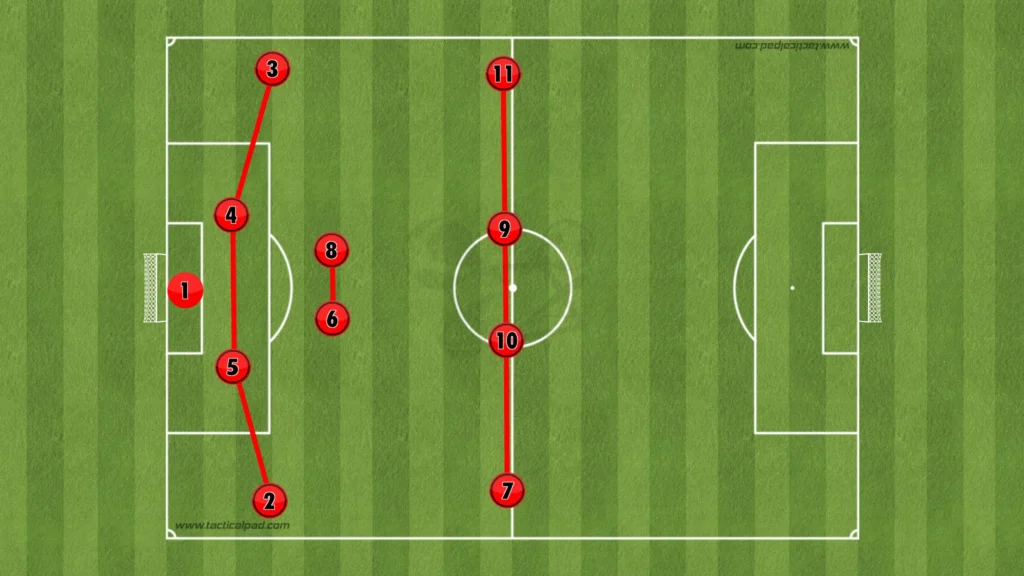
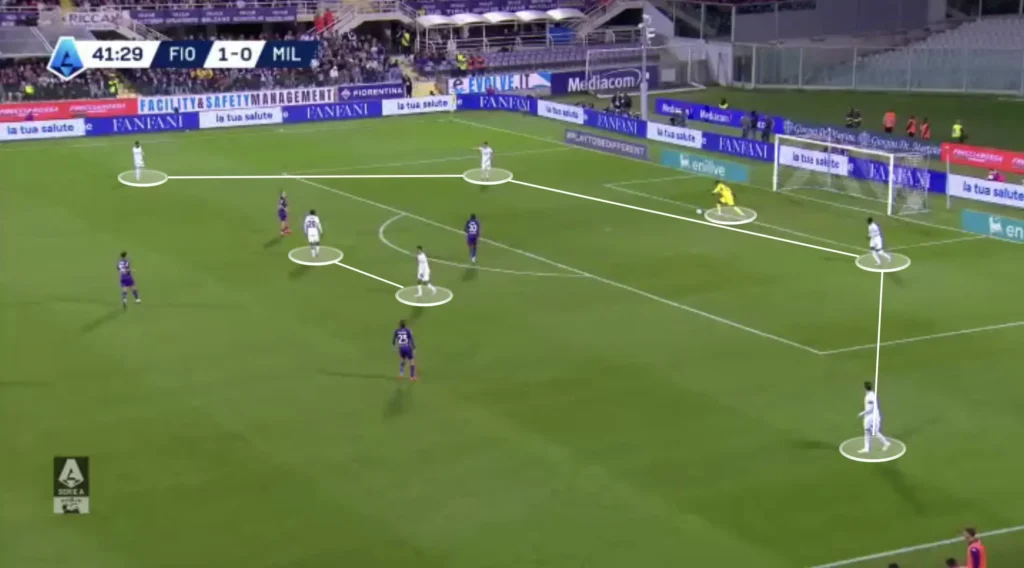
The goalkeeper, Mike Maignan, often moves up between the center-backs in the low build-up. He will move slightly to the right, with the right center-back pushing out and the right-back pushing up. When the right-back pushes up, the right-winger often drops into the midfield.
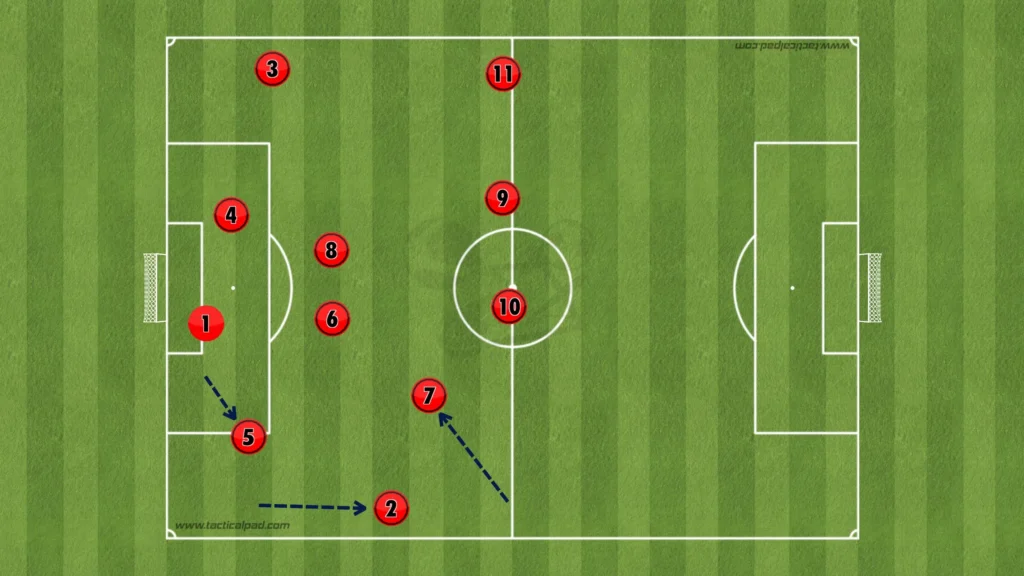
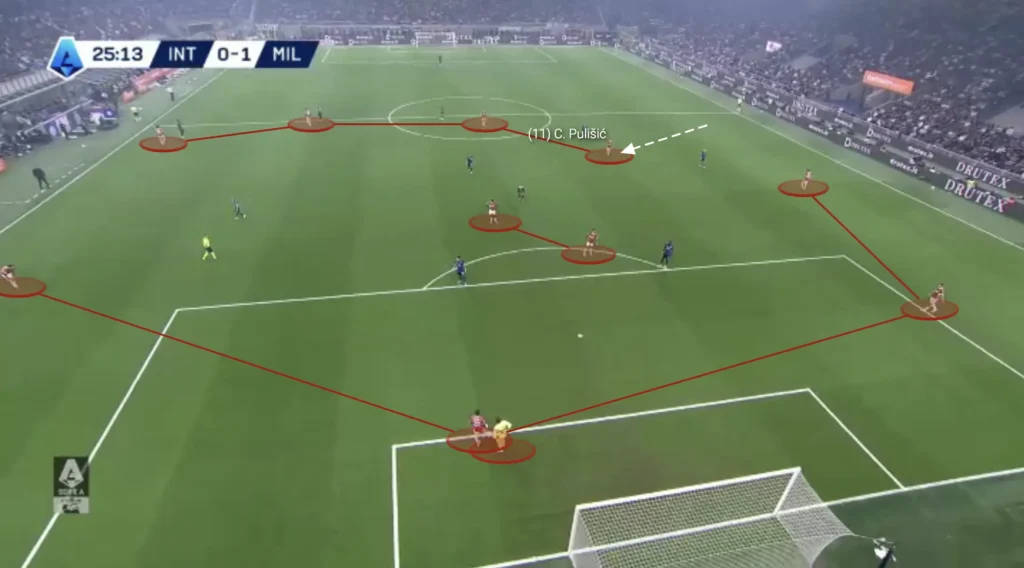
When the right-winger drops into the midfield, the opposition left-back has to make a decision: either follow the winger or stay in the backline. If the left-back stays back, the dropping winger will be unmarked, which often gives Milan a numerical superiority in the midfield. If the opposition left-back follows the dropping winger, the Milan right-back can push up even higher and receive the ball in the space behind the left-back.
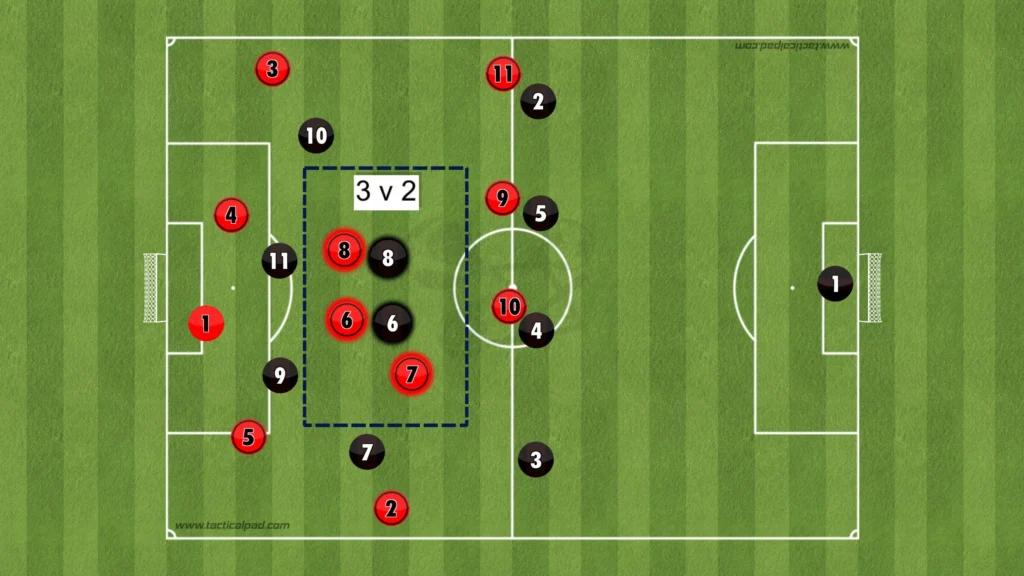
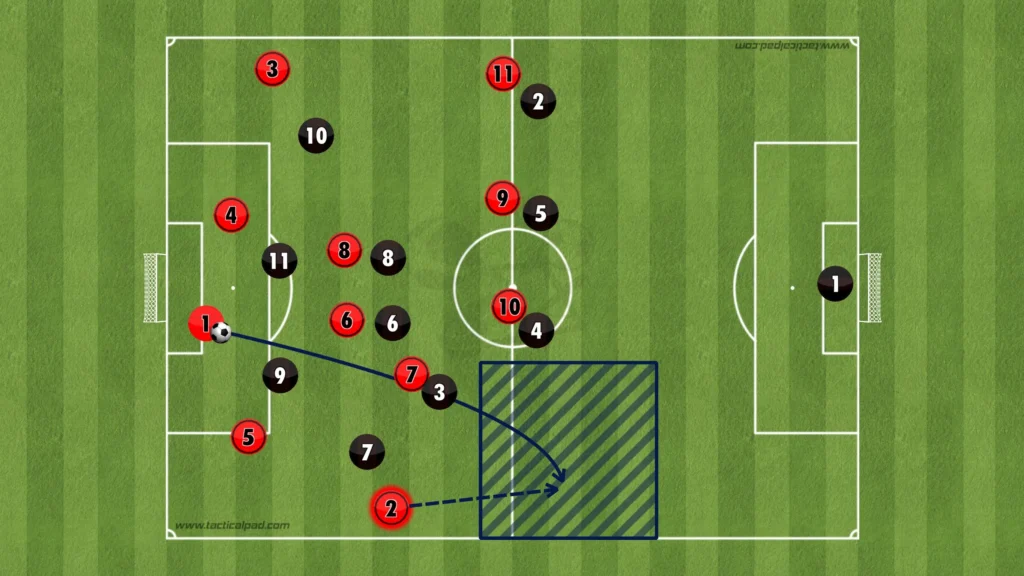
High Build-up
In the high build-up, Fonseca usually sets his team up in a 1-4-3-3 formation, with a back four, one number-six, two number-eights, and a front three.
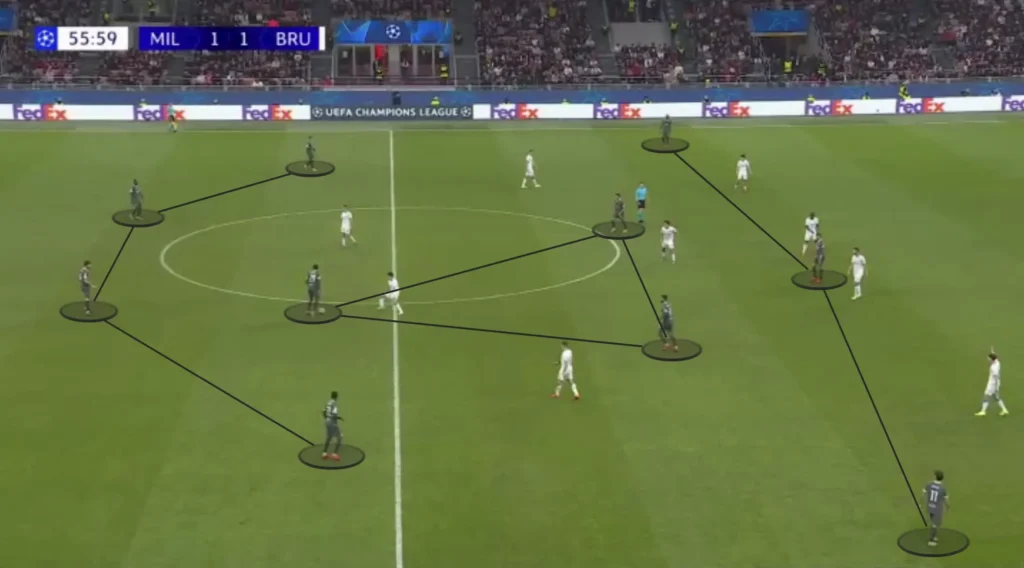
Building up in a 1-4-3-3 formation focuses on creating a solid foundation at the back while maintaining fluidity and options in the midfield. The formation begins with four defenders, who provide width and stability, allowing for controlled possession from deep areas. The single defensive midfielder connects the defense to the midfield, dictating the tempo and distributing the ball to the two more advanced central midfielders. These midfielders position themselves to exploit spaces between the opposition’s lines, creating passing triangles that facilitate smooth progression up the pitch. The three forwards, with the central striker as the focal point, are always ready to receive the ball, either through direct passes or by making runs behind the defense. This setup allows the team to transition quickly from attack to defense, maintaining pressure on the opponent while ensuring defensive coverage.
The Milan right-winger often drops into the midfield during the high build-up, adding an extra layer of support and creating numerical superiority in central areas.

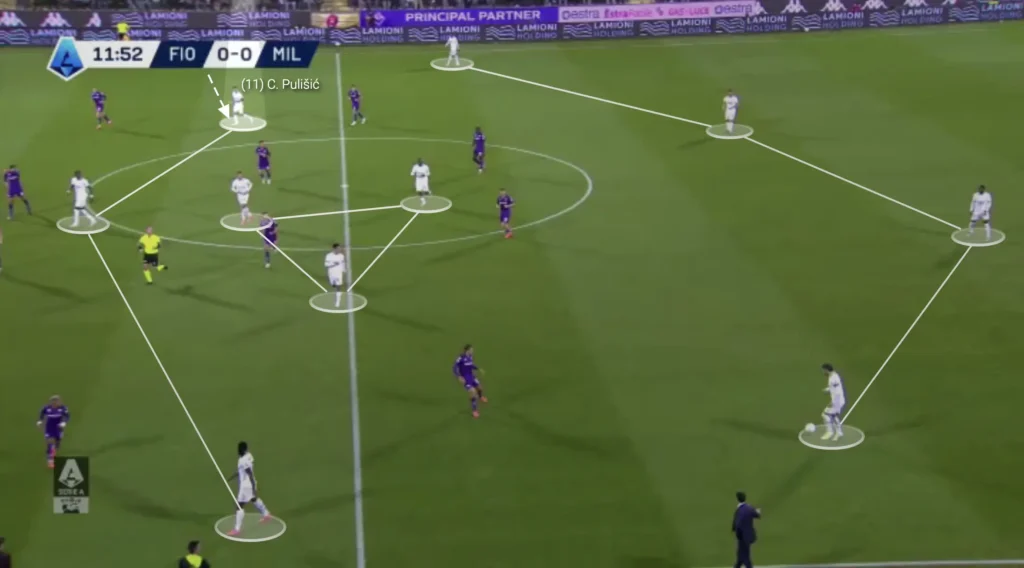
By moving inside, the winger helps to draw out opposition defenders, opening up space on the right flank for overlapping runs from the right-back. This positioning allows Milan to control the tempo and maintain possession, often forcing the opposition midfield to adjust and leaving gaps in their defensive structure. This also leaves two Milan players on the left side and only one player on the right side.
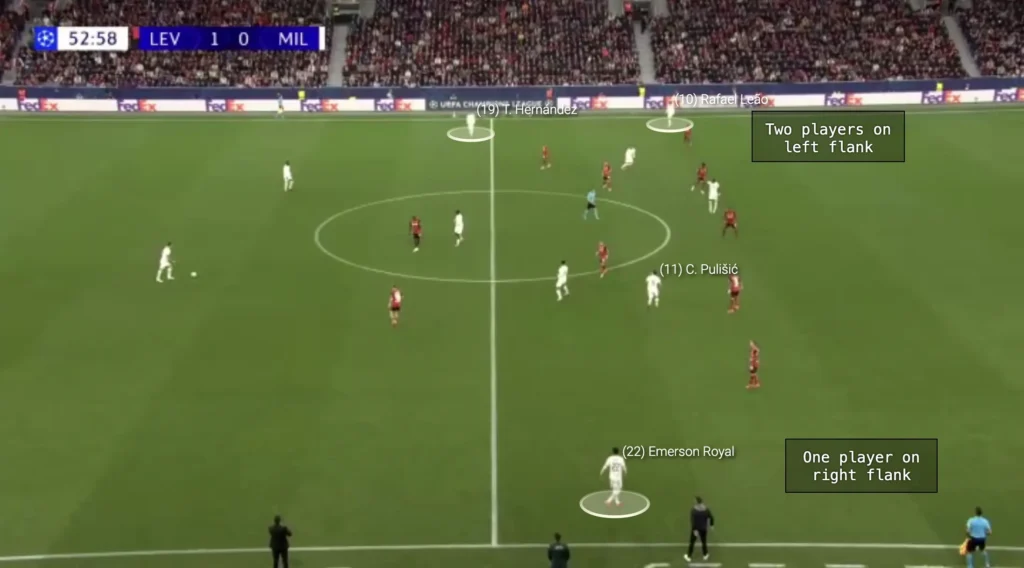
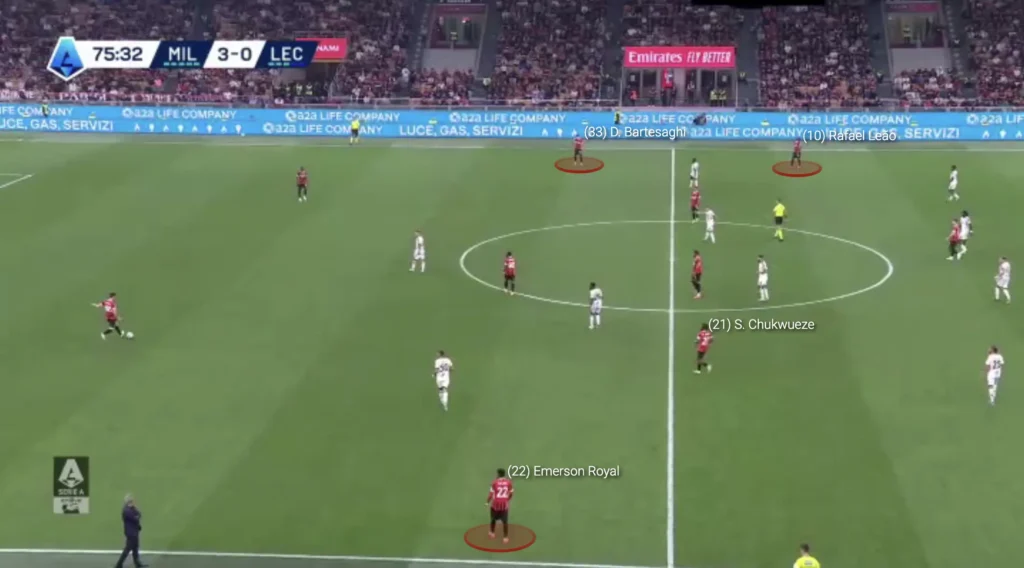
Therefore, Milan usually focus the attacks on the left side, where Theo Hernandez and Rafael Leão often will combine to beat the opposition’s defense.
Numerical Advantage in the Midfield
Additionally, when Milan’s right-winger drops into the middle during the build-up, it frequently provides a numerical advantage in the midfield, giving Milan an edge over opposing teams.
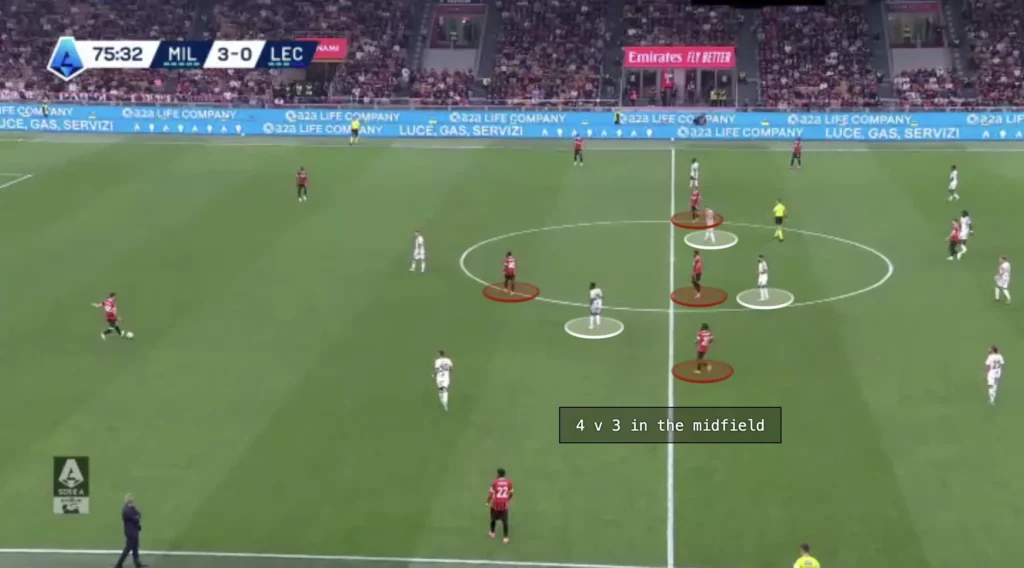
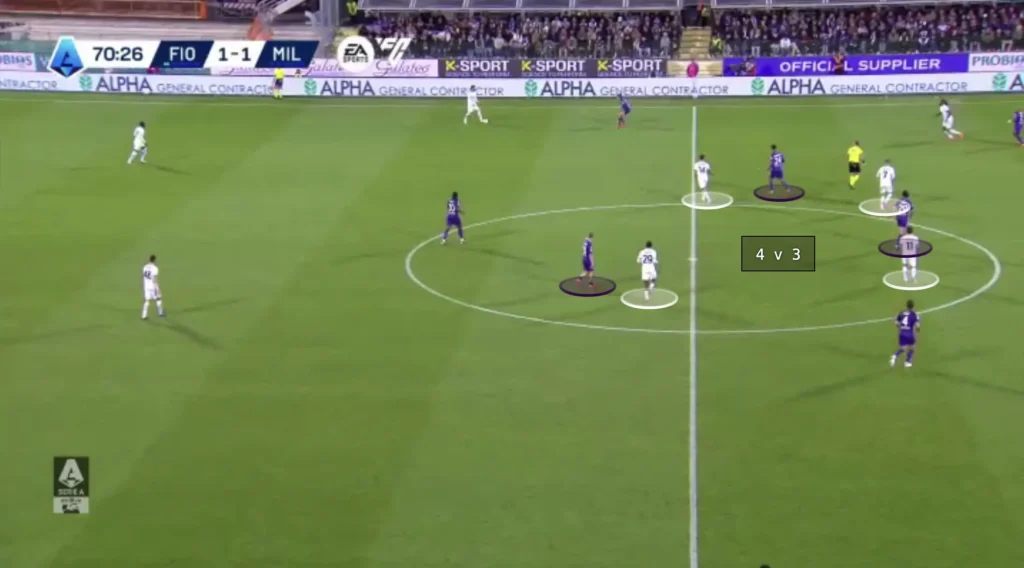
By adding an extra body to the midfield, Milan can create overloads, often outnumbering the opponent’s midfielders. This tactic forces the opposition to either leave one of Milan’s midfielders unmarked or pull an additional player in to cover, which can disrupt their defensive shape. With more passing options, Milan can circulate the ball more effectively, allowing them to retain possession and find gaps in the opposition’s setup. This numerical superiority not only helps Milan bypass the press more smoothly but also frees up space for quick attacks, as defenders are often drawn out of position. The added presence in midfield becomes a pivot for creating dynamic movements and generating attacking momentum further up the field.
Rotations and Fluidity
The Milan players constantly rotate during the build-up. The team adopts a dynamic approach, shifting between formations to create numerical advantages and exploit spaces. Fonseca’s focus is always to get the players into their best positions, where they can make the most out of their individual skills. He emphasizes versatility, with players interchanging positions seamlessly to maintain possession and disrupt the opposition’s defensive structure. This flexibility creates numerical superiorities in different areas, allowing Milan to bypass the opposition’s press while maintaining control.
The striker will, for example, often drop deeper into midfield, drawing defenders with him and creating space for midfielders or wingers to make penetrating runs.
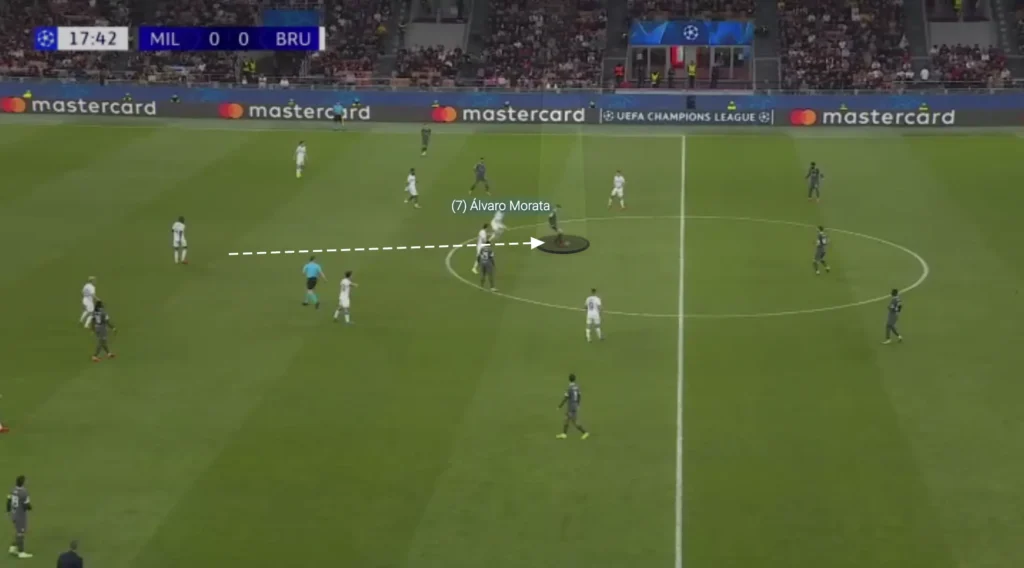
Meanwhile, the fullbacks frequently push up into the midfield, adding support in the central areas while isolating 1v1 situations for the wingers out wide.
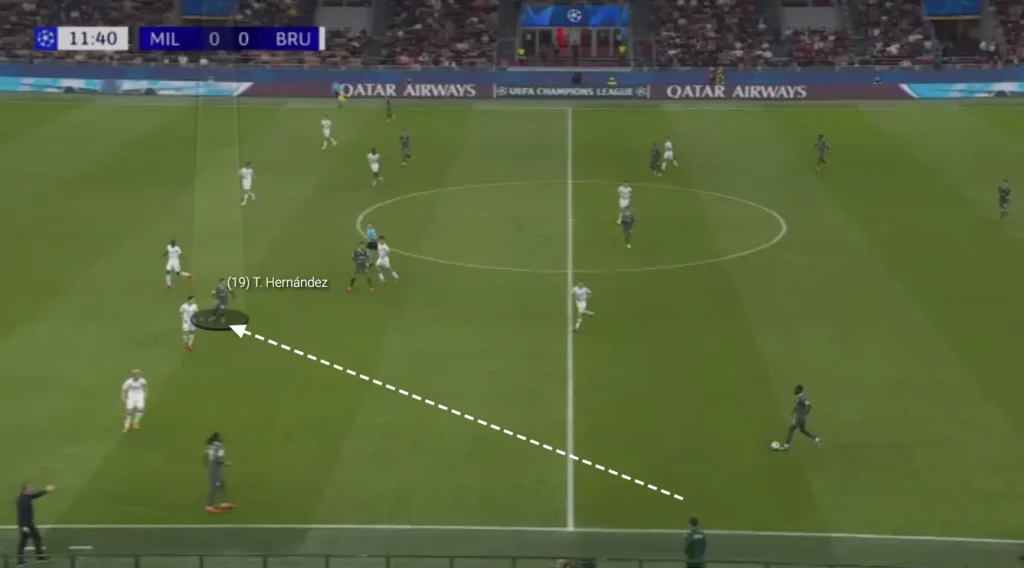
AC Milan will also frequently rotate into a 1-3-2-2-3 formation during their build-up to maximize passing options and control the midfield. In this setup, one of the full-backs shifts inside to join the center-backs, creating a back three that stabilizes possession and offers support against the press. The central midfielders push slightly higher, forming a box shape with two attacking midfielders, which adds vertical passing lanes and numerical superiority in the central areas. This structure also frees up the wingers to stay wide and stretch the opposition, allowing Milan to switch play effectively and create chances through dynamic off-the-ball movement.
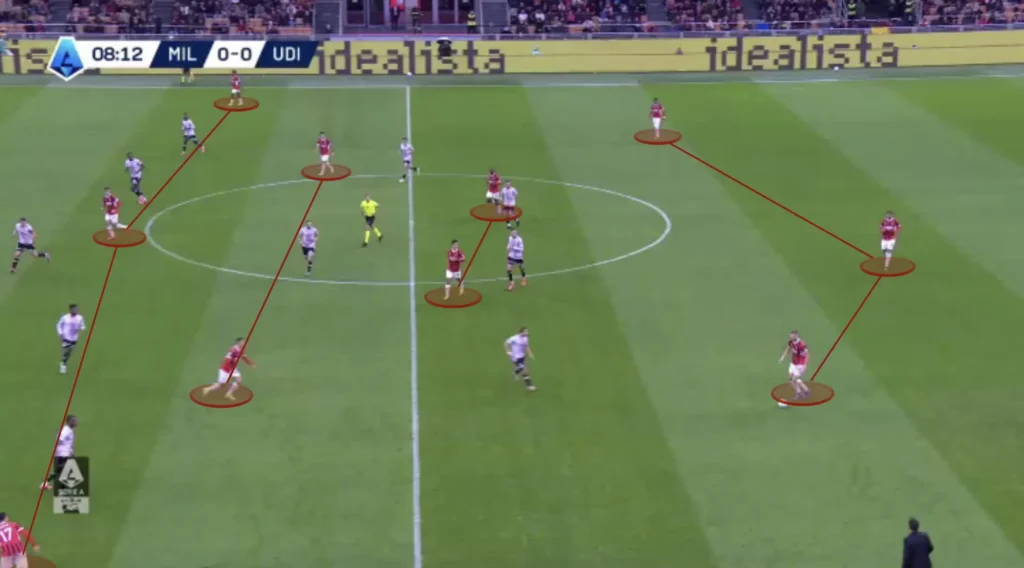
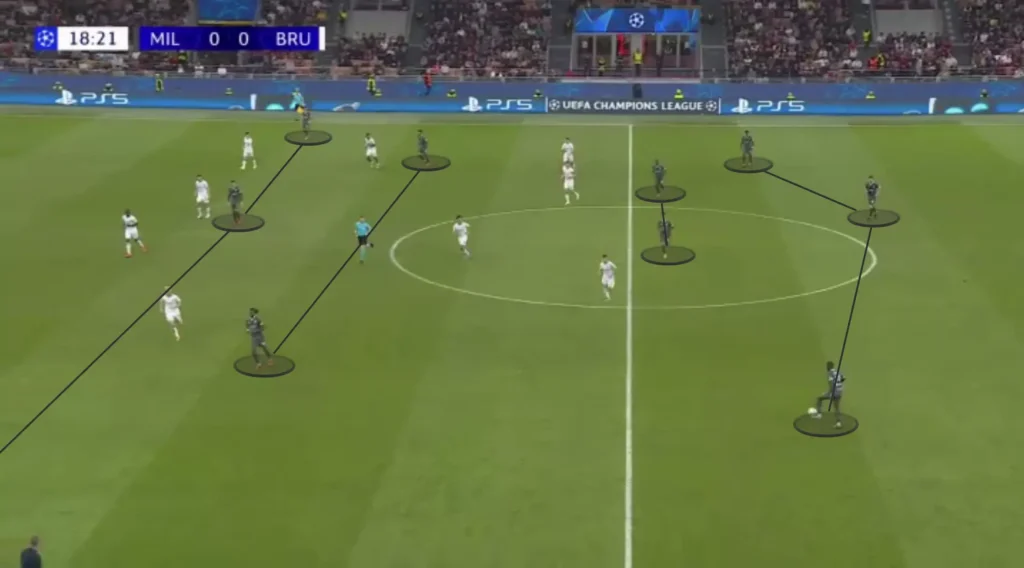
While it demands a lot of technical and tactical skills from the players, this fluidity has created new dynamics for Milan’s attacking style, offering new solutions and ways of beating the opposition’s press. It enhances their ability to control the game while opening up opportunities for incisive passes and creative plays.
Using the Goalkeeper
Paulo Fonseca likes using the goalkeeper in the build-up. The Milan goalkeeper, Mike Maignan, will often push up between the center-backs, giving Fonseca’s team an extra man in the build-up phase.
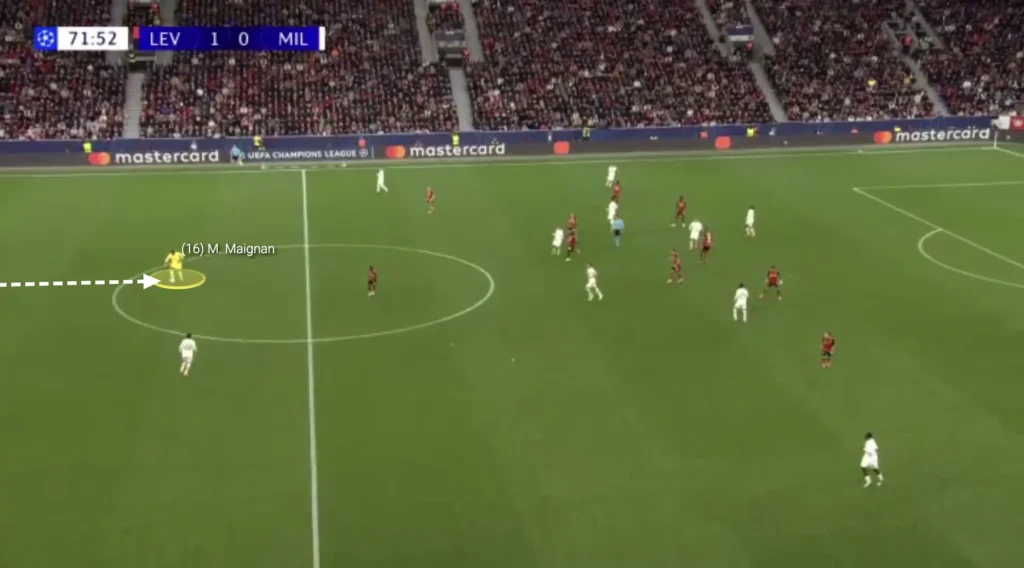
Using the goalkeeper in the build-up phase offers numerous tactical advantages. By involving the goalkeeper, Milan can create numerical superiority at the back, making it easier to evade the opponent’s press and maintain possession. This additional player allows for more passing options, reducing the risk of losing possession and enabling smoother transitions from defense to attack. The goalkeeper can also act as a pivot, switching play across the field to exploit weak points in the opposition’s formation. Furthermore, involving the goalkeeper helps in drawing the opposition forward, creating space higher up the pitch for attackers to exploit.
High Backline (Off)
A massive aspect of Fonseca’s high build-up is to have the defenders high up and close to the center. This helps in the counterpress because they get closer to the midfield. Having more players close to the center who can win the ball back makes it difficult for the opposition to do anything when they win possession. Furthermore, the high backline shortens the distance between players, shortening the time and length of the passes and preventing the opposition from pushing up their defense.

Finding the Pockets
Fonseca’s players always try to find the attacking midfielders in the pockets. These “pockets” refer to the spaces between the opposition’s defensive and midfield lines, where the attacking midfielders can receive the ball in more advanced positions.
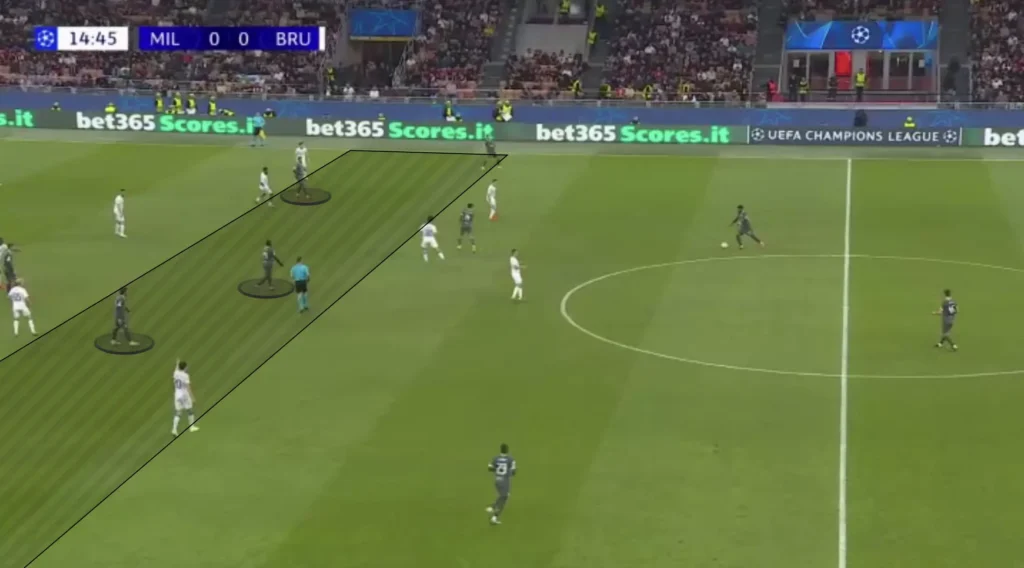
By positioning themselves intelligently in these pockets, the attacking midfielders can turn quickly and face the opposition’s goal, creating opportunities for through balls, driving runs, or direct shots. This positioning forces the opposition to make difficult decisions. If an opposition defender steps up and closes down the attacking midfielders, he potentially leaves space behind. If he stays back, he allows the attacking midfielders time on the ball. The Milan defenders and holding midfielders will look for straight passes, breaking the opposition lines and finding the attacking midfielders who can turn and drive at the defense.
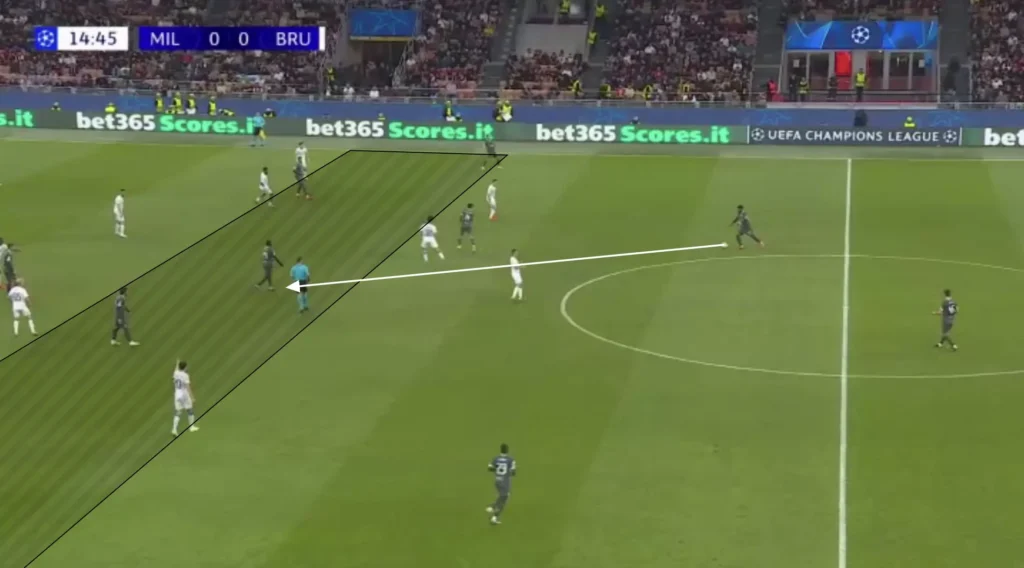
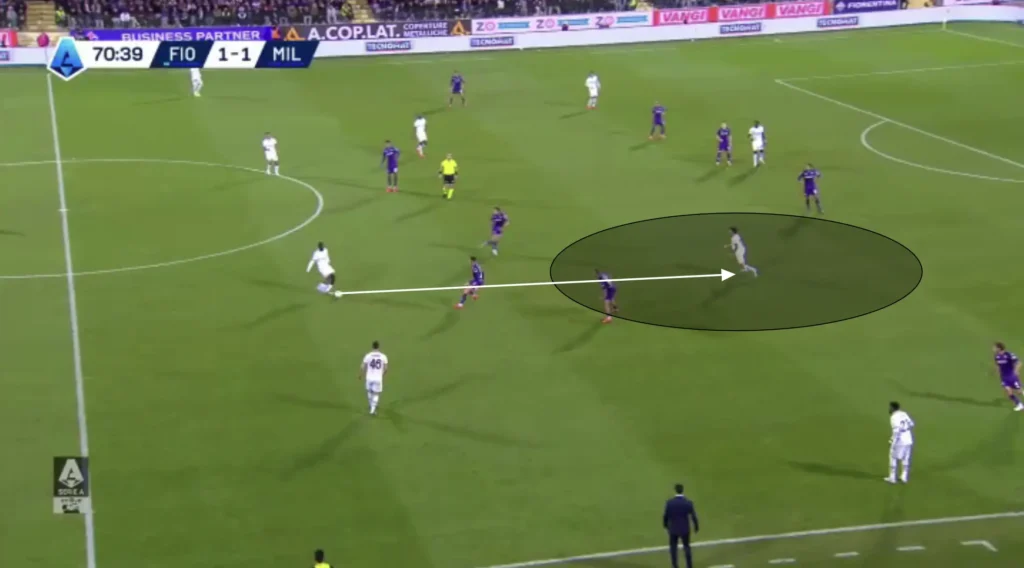
Finding these pockets is crucial for maintaining fluidity in attack and ensuring that the team can progress the ball effectively through the middle of the pitch.
Many Players in the Box
AC Milan consistently emphasizes getting multiple players into the box, creating a chaotic environment for defenders, and increasing their chances of scoring. The wingers, midfielders, and sometimes fullbacks look to make aggressive runs into the box when the ball is in the final third, often getting four or five players into these areas to create overloads.
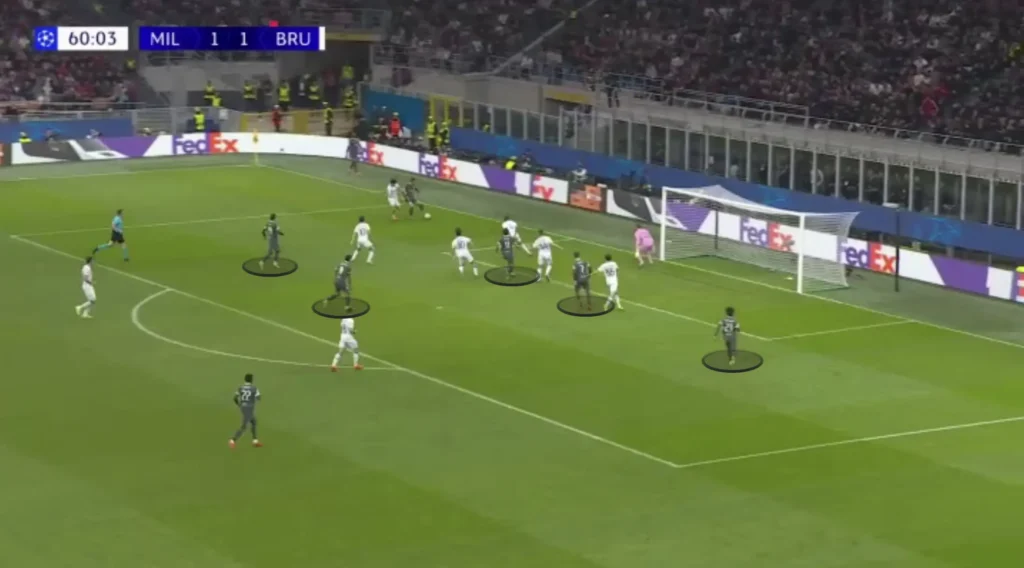
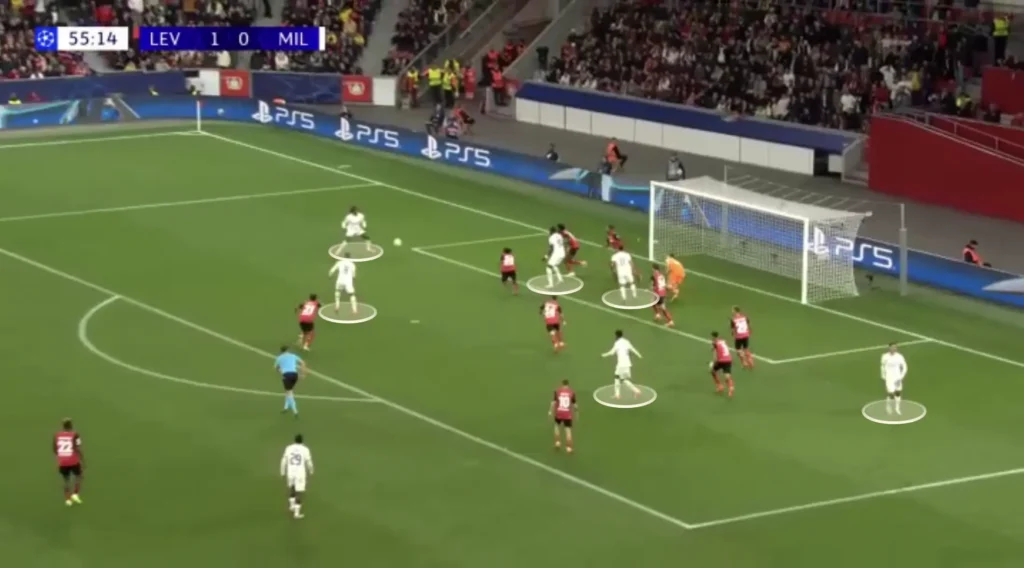
The numerical advantages in the box increase the chances of connecting with the cross, as more players present multiple targets for the crosser, making it harder for defenders to mark everyone effectively. Additionally, having multiple players in the box provides options for different types of finishes, whether it’s a header, volley, or a quick tap-in. It also allows for better positioning to react to second balls or rebounds, increasing the likelihood of capitalizing on any defensive errors.
Fonseca also positions many players outside the box, ready for the second balls and cut-backs. Milan will often create crossing opportunities, which pushes down the opposition’s defense and opens the space in front of the opposition’s backline. The holding midfielders can collect any loose balls or be found directly in these spaces with cut-backs, and from there, they can shoot or combine with an attacker to create goalscoring opportunities.
Counterattacks
AC Milan’s counterattacks under Paulo Fonseca are sharp, direct, and well-coordinated. With an emphasis on quick transitions, Milan immediately shifts to an attacking mindset when winning possession, using fast-paced outlets like Rafael Leão and Christian Pulisic on the wings. Fonseca’s setup allows Milan to stretch the field, exploiting spaces left by opponents caught off-balance. Key to these counters is Milan’s midfield, particularly with players who can make precise, forward passes to launch quick attacks. The attackers coordinate their runs effectively, creating options both centrally and out wide, which makes Milan’s counterattacks unpredictable and difficult to defend against. This approach adds a potent edge to Milan’s offense, allowing them to strike decisively when opponents least expect it.
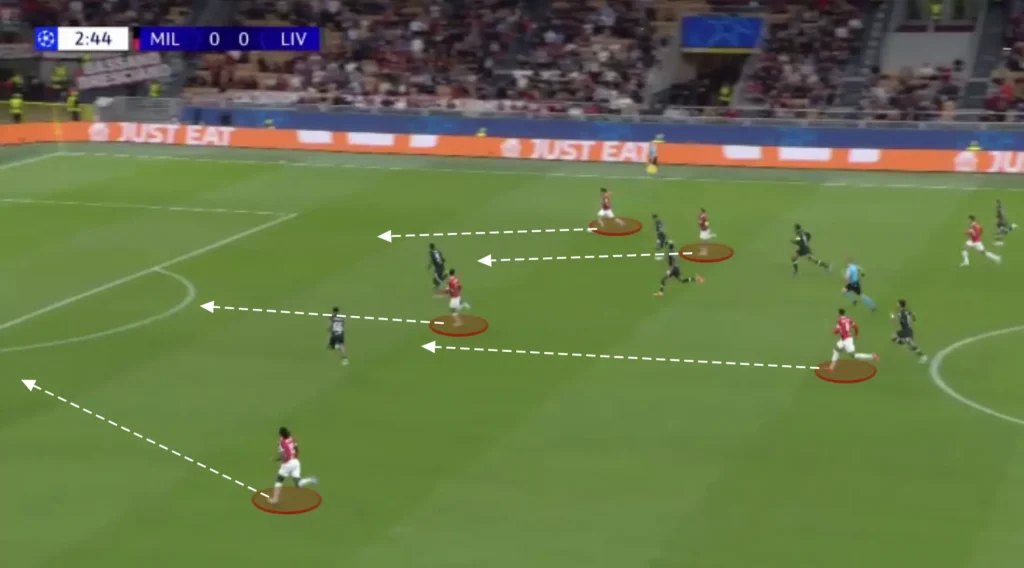
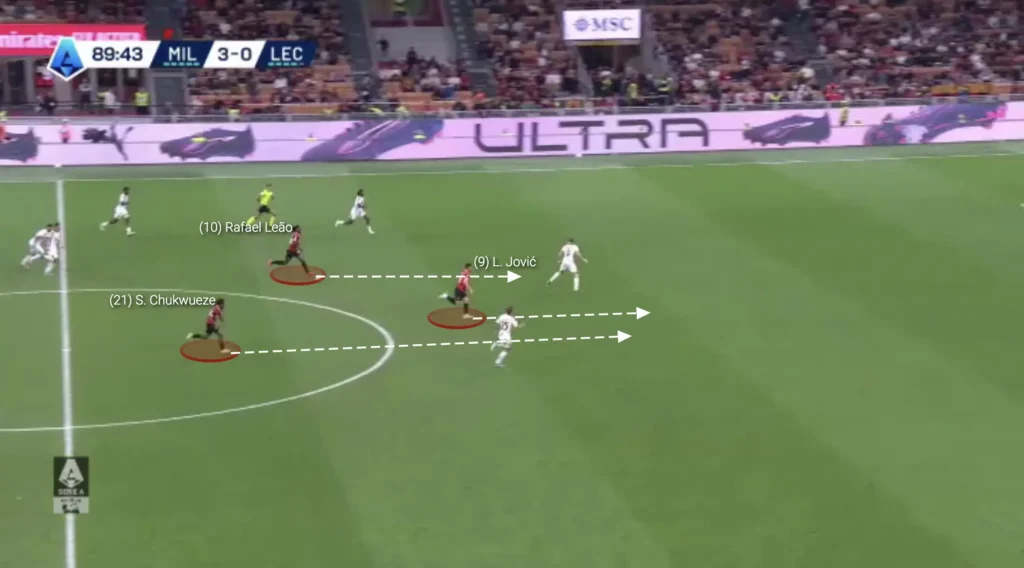
Defending
High Press
Paulo Fonseca’s AC Milan has adopted a high and intense man-to-man pressing strategy that sets the tone for their aggressive style of play. The Milan players will close down every opponent when the opposition has the ball at the back, creating a sense of urgency and chaos in the opposition’s build-up phase. Each player is assigned a specific marker, ensuring that no opponent has time or space to operate effectively. This cohesive and relentless pressing system not only disrupts the opponent’s rhythm but also allows AC Milan to regain possession quickly, often leading to swift counterattacks and goal-scoring opportunities. Fonseca’s emphasis on intensity and coordination in pressing highlights his commitment to an attacking philosophy that seeks to dominate both possession and the pace of the game.
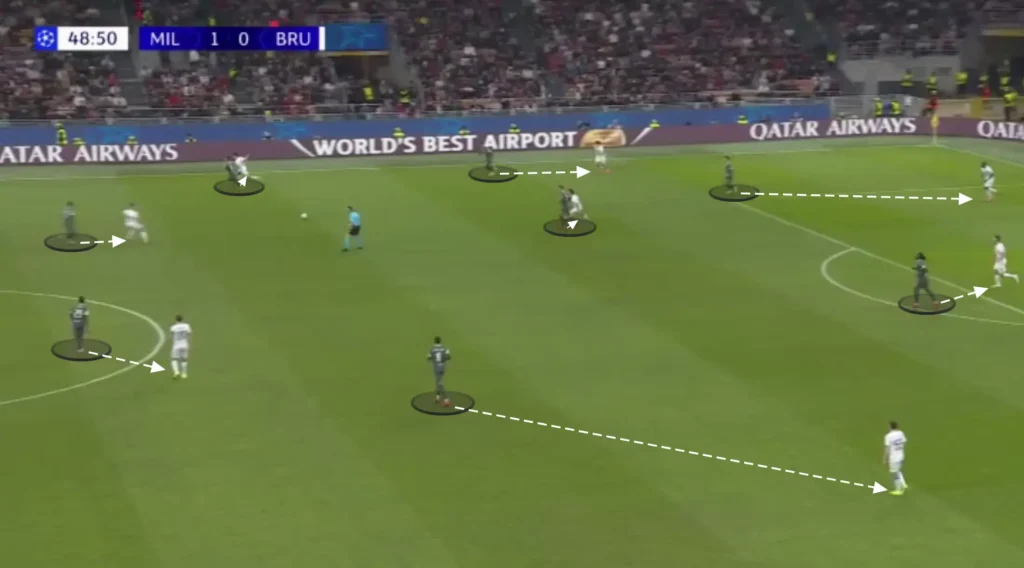
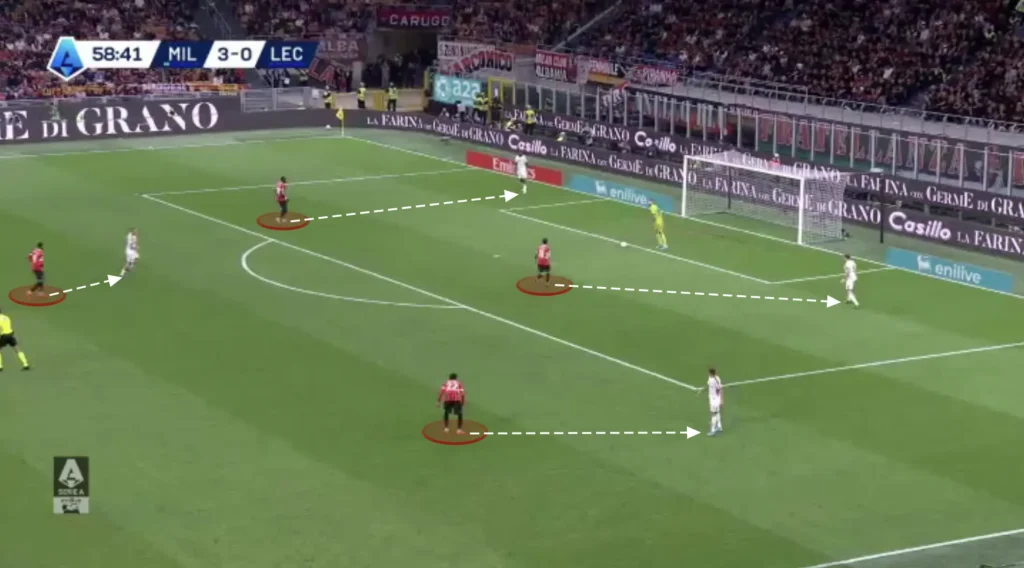
In a man-to-man system, it becomes crucial that the players know when to mark the opponent they are responsible for and when not to. If an opponent, for example, is very far from the ball, the Milan player marking him does not need to be as close to him. He can instead come in and help create numerical superiorities in the center, decreasing the risk of dangerous 1v1 situations. The Milan players will always have an opposition player they are responsible for. However, they will never be closer to them than they need to be. Here, for example, the ball is on the left side, allowing the Milan player on the right side to stop marking his opponent as closely and come into the middle.
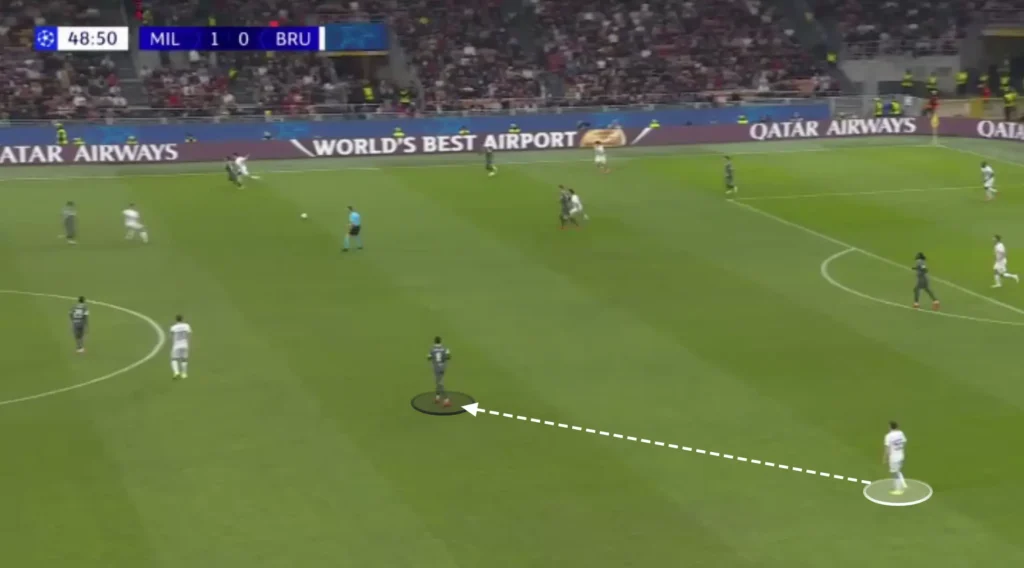
A rule of thumb for the players could be that the closer you are to the ball, the closer you need to be to your opponent. The further away you are from the ball, the further away you can be from your opponent.
Mid Press
1-4-2-4
AC Milan’s base formation when defending is the 1-4-2-4 formation. They look to set up in a mid-block, always trying to close the center and force the opposition out wide. Defending in a 1-4-2-4 formation requires a careful balance between pressing high and maintaining defensive solidity. The two central midfielders play a crucial role, acting as the primary shield in front of the back four while also supporting the press when the team looks to regain possession. The front four must press aggressively, cutting off passing lanes and forcing the opposition into mistakes. The back four stays compact, with fullbacks responsible for covering wide areas while center-backs maintain a solid shape. Overall, the success of defending in this formation hinges on coordinated pressing, quick transitions, and disciplined positioning to avoid being exposed in central areas.
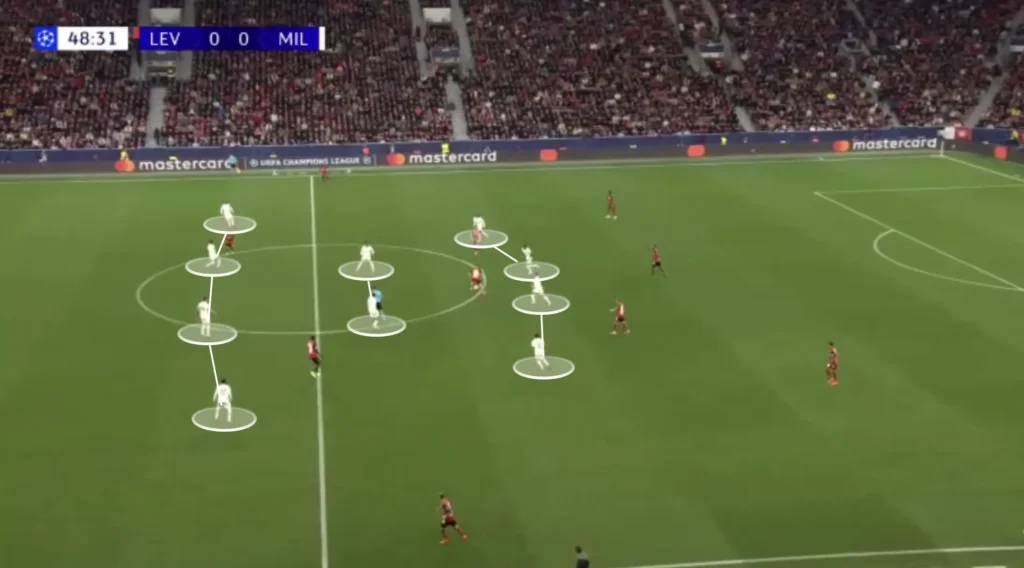
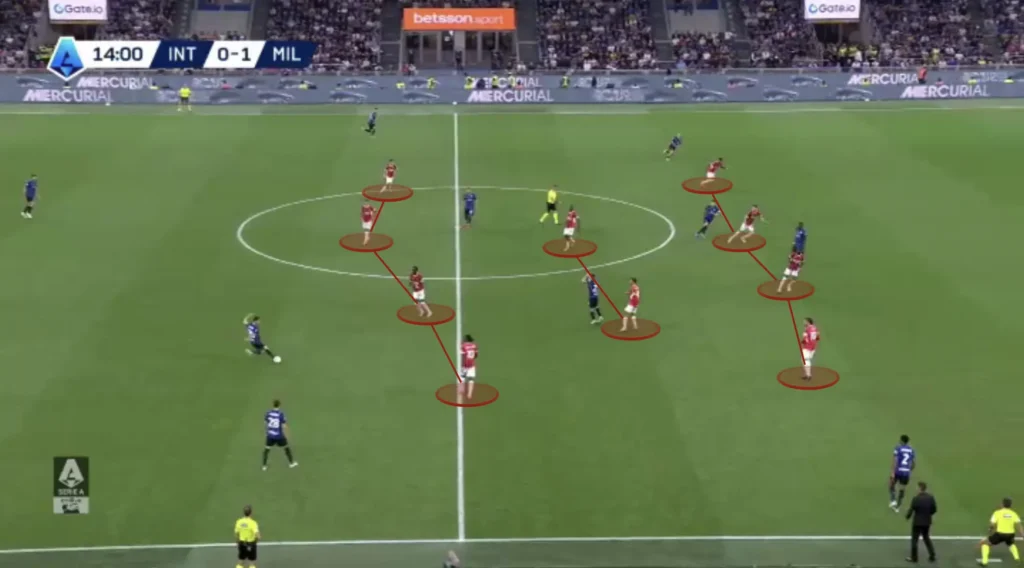
In AC Milan’s defensive system, the wingers will usually press the opposition center-backs while the strikers cover the opposition’s holding midfielders. When the wingers press the center-backs, they close the passing lanes to the opposition fullbacks/wingbacks. This forces the opposition center-backs into the middle, where Fonseca wants to win the ball with the strikers, who block off all passes into the opposition’s midfielders.
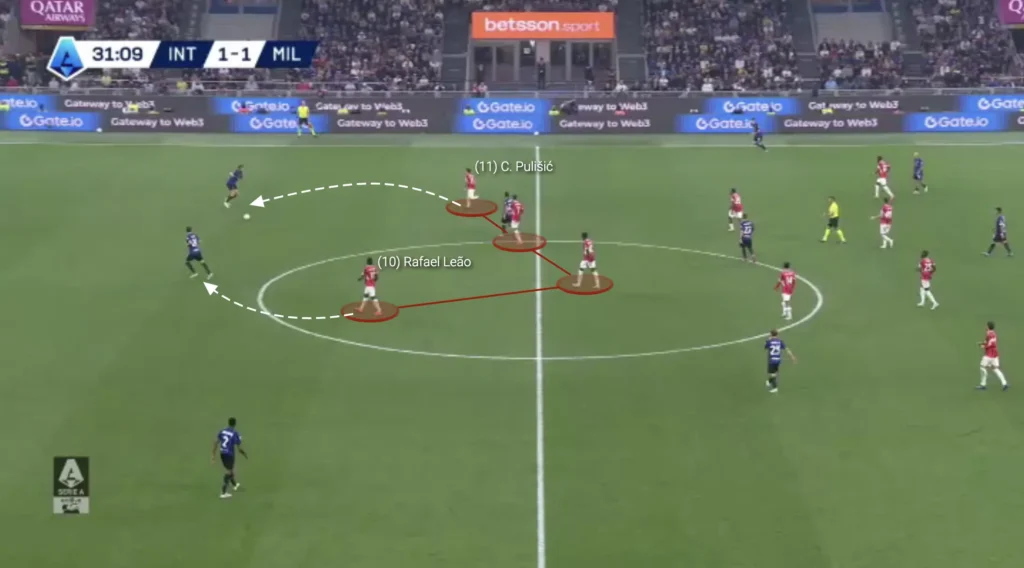

If the opposition moves the ball out to the side and tries to progress the ball through the flank, a central midfielder will break out to stop the opposition from advancing. If a central midfielder breaks out, the remaining midfielder must shift across while the winger drops back, closing any passes into the midfield.
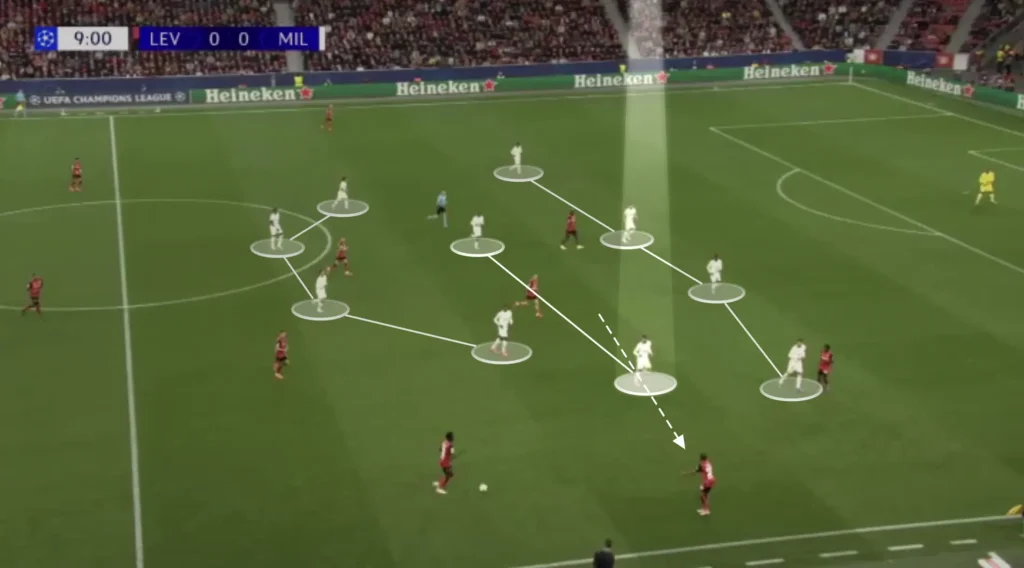
1-4-3-3
In the most recent games, Milan have used a 1-4-3-3 formation when defending. This formation change has given Milan one more central midfielder, which allows them to better close the spaces in the midfield. However, it has taken away one of the strikers, which makes the forward line easier to play through.
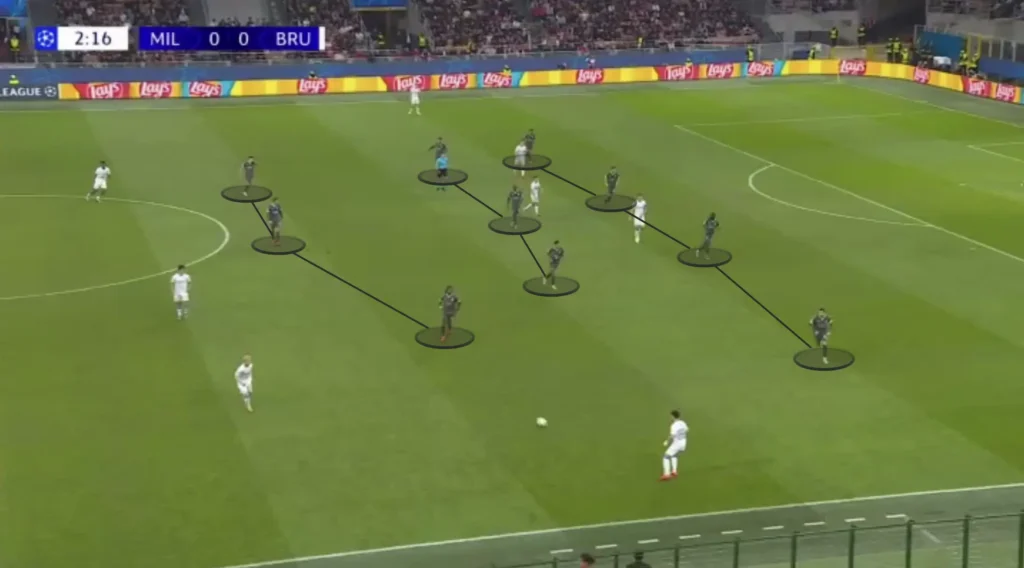
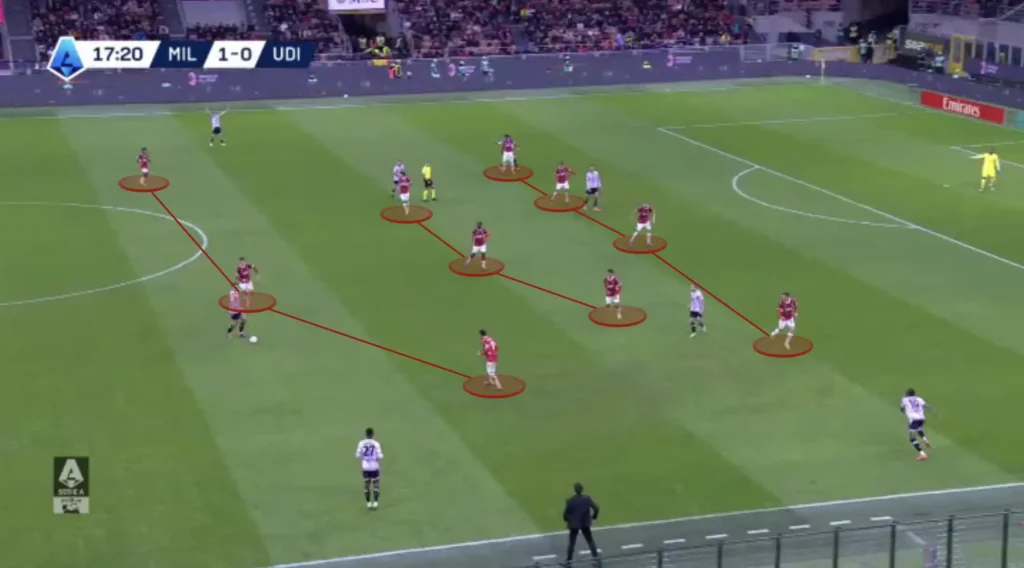
In the 1-4-3-3 formation, they still set up in a compact mid-block, looking to press the opposition center-backs with the wingers and close down the wide areas with the central midfielders. The 1-4-3-3 is, much like the 1-4-2-4 formation, effective in closing down the center of the field, making it difficult for opponents to penetrate through the middle and pushing them into less dangerous wide areas.
High Backline (Def)
One tool that helps to be compact is to play with a high backline, making the space to the midfield line as small as possible. Fonseca’s players do this and usually try to keep the highest line they can without leaving the space behind them too open. Defending with a high backline involves positioning the defensive line closer to the midfield rather than near the goalkeeper. This tactic compresses the space available for the opposing team to operate, disrupting their build-up play and increasing the chances of winning the ball back quickly.
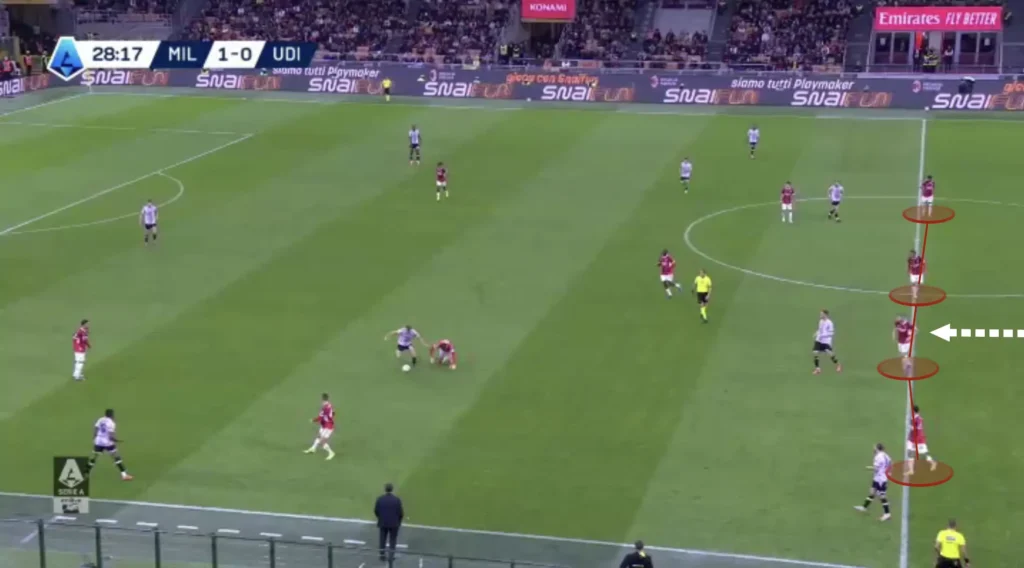
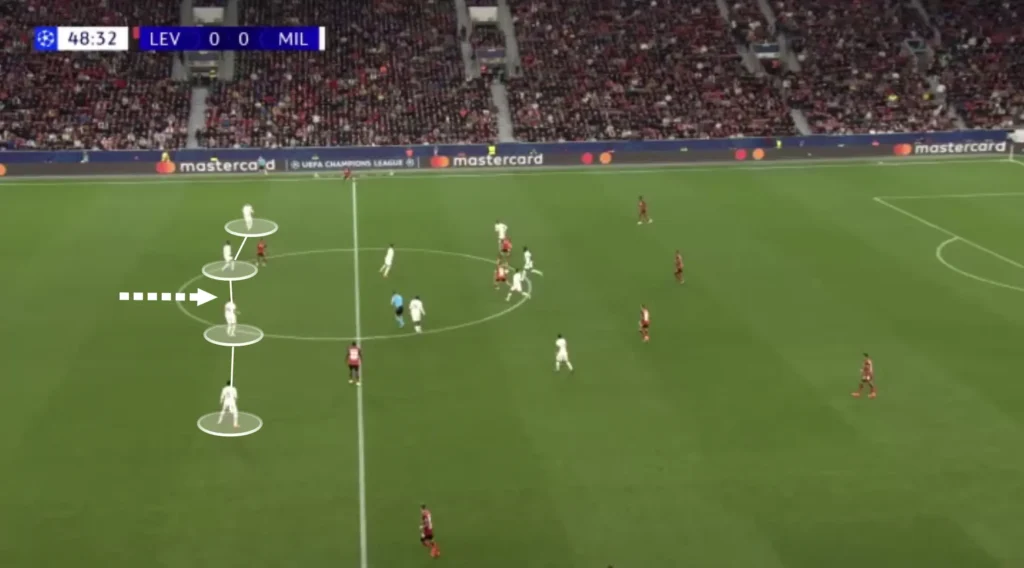
A high backline also allows defenders to support the midfield more effectively, creating numerical superiority in central areas and facilitating quicker transitions from defense to attack. However, it requires defenders with good pace and positional awareness to deal with long balls and prevent opposing attackers from exploiting the space behind. This approach demands constant communication and coordination among the backline to maintain a cohesive and effective defensive structure.
Additionally, everyone must be in the same line when defending with a high backline to maintain an effective offside trap, ensure cohesive coverage, and reduce gaps that attackers can exploit. A well-aligned defensive line makes it easier to catch opposing forwards offside, preventing them from receiving the ball in dangerous positions.
Body Position
Another crucial detail that Fonseca focuses on is the defender’s body position. He wants them to play side-on, being ready to run both forward and backward. Tracking a run in behind is more difficult when facing forward than if you play side-on. If you are facing forward, you have to turn your entire body before starting to run. Playing side-on gives a quicker reaction time, enabling faster movement in both directions. Fonseca, therefore, wants his defenders to play side-on.
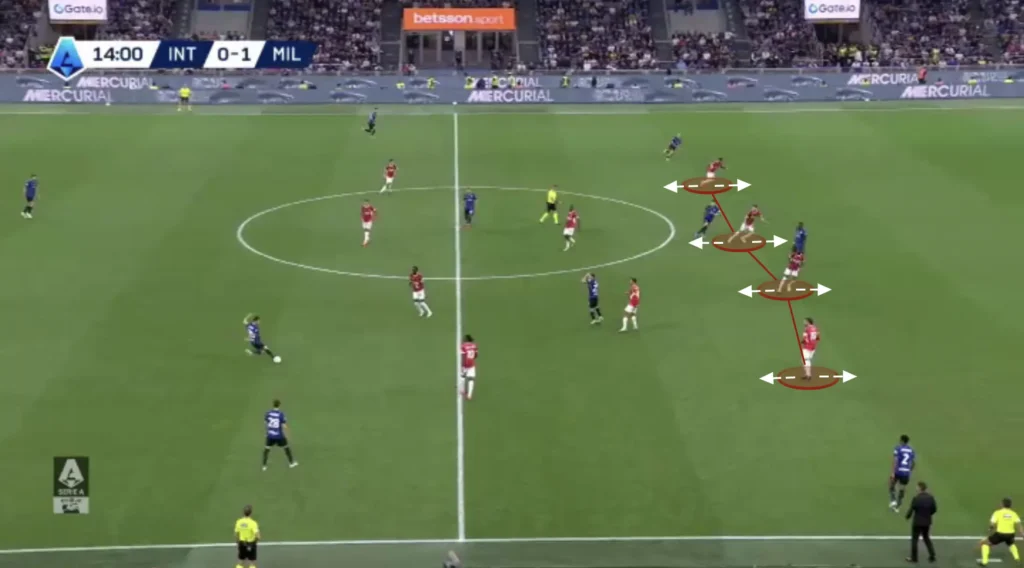
Squeezing the Pitch
Paulo Fonseca also wants his team to squeeze the pitch when defending. This means constantly pushing the team up as much as possible. Every time the opponent plays a slow, sideways pass or a back pass, Milan’s first line of pressure pushes up, with the rest of the team following to stay compact. When the next pass comes, they push up even more, forcing the opponent back even more.

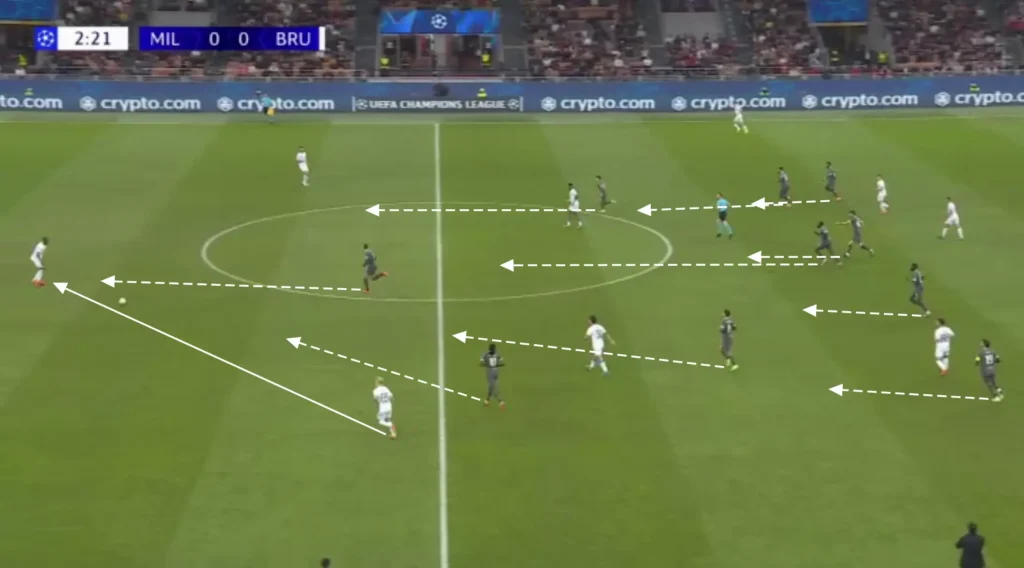
This approach keeps opponents under constant pressure, making it difficult for them to build rhythm or find space between the lines. It also pushes the opponent further away from Milan’s goal, making it harder to create chances.
Final Thoughts
In conclusion, Paulo Fonseca’s AC Milan presents a blend of tactical innovation and disciplined structure, bringing a fresh style to Serie A. His approach emphasizes fluid attacking play, quick transitions, and defensive organization, highlighting his adaptability and ability to get the best out of his squad. By leveraging player strengths and tactical versatility, Fonseca has crafted a Milan side capable of adjusting to different challenges while maintaining a cohesive identity.
As Fonseca continues to shape AC Milan’s game, his tactical influence could be pivotal for the club’s ambitions this season. This analysis of his methods underscores a commitment to dynamic and intelligent football, promising an exciting path ahead for Milan under his guidance.
